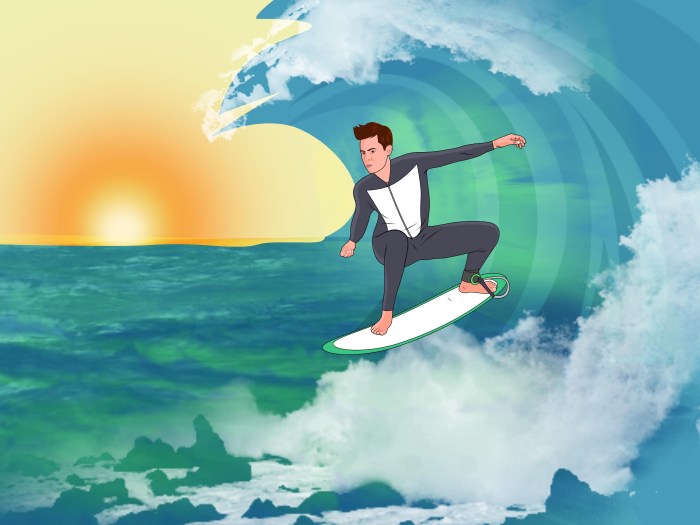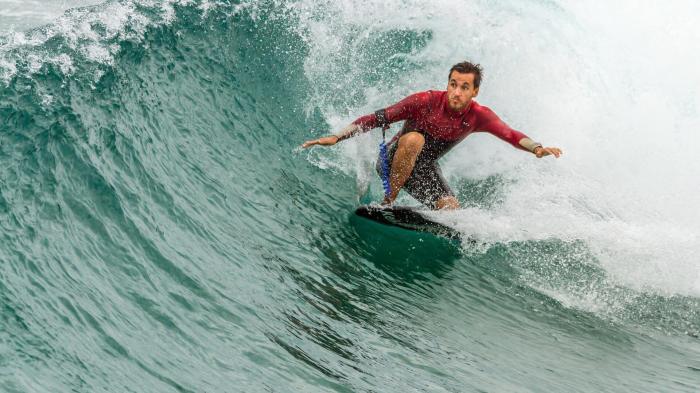Surfing basics are where it all begins – from riding the waves to understanding the culture. Get ready to dive into the world of surfing with this ultimate guide.
Whether you’re a newbie or looking to brush up on your skills, this comprehensive Artikel covers everything you need to know to conquer the waves like a pro.
Surfing Basics
Surfing is a popular water sport that involves riding waves on a surfboard. It has deep cultural significance in coastal communities around the world, symbolizing freedom, connection to nature, and a laid-back lifestyle.
Equipment Needed for Surfing
- Surfboard: The most essential piece of equipment, available in various shapes and sizes depending on skill level.
- Leash: Attaches the surfer to the board to prevent it from drifting away.
- Wetsuit: Provides insulation and protection from cold water.
- Wax: Applied to the surfboard for better traction and grip.
Types of Surfboards for Beginners
- Soft-Top Surfboards: Ideal for beginners due to their stability and forgiveness.
- Longboards: Provide better balance and easy paddling for novice surfers.
- Foam Boards: Lightweight and buoyant, making it easier to catch waves.
Importance of Safety Precautions for Surfing
Surfing can be a thrilling experience, but safety should always come first. It is crucial to:
- Respect the ocean and its power.
- Learn how to swim confidently in case of emergencies.
- Wear appropriate safety gear, such as a leash and a well-fitted wetsuit.
- Follow surf etiquette and rules to avoid collisions with other surfers.
Getting Started

When you’re ready to hit the waves, here’s how to get started with surfing basics. Paddling out into the waves is the first step to catching that perfect wave and riding it like a pro. Once you’re out there, it’s all about finding your balance and getting up on the board. Here are some tips to help you get started on your surfing journey.
Paddling Out Into the Waves
To paddle out into the waves, lie on your stomach on the surfboard and use your arms to paddle out past the breaking waves. Make sure to keep your body centered on the board to maintain balance. As you paddle, look out for incoming waves and try to time your paddle so you can get past them easily.
Catching a Wave and Getting Up on the Surfboard
When you spot a wave you want to catch, start paddling towards it. As the wave approaches, paddle quickly and smoothly to match its speed. Once you feel the wave pick you up, pop up onto your feet in one fluid motion. Keep your knees bent and your arms out for balance as you ride the wave towards shore.
Proper Stance and Balance Techniques
For beginners, the proper stance on a surfboard is crucial. Keep your feet shoulder-width apart and parallel to the stringer of the board. Bend your knees slightly to maintain balance and keep your weight centered on the board. Practice shifting your weight as you turn and maneuver on the wave.
Improving Paddling Speed and Efficiency
To improve your paddling speed and efficiency, focus on using your entire arm to paddle rather than just your hands. Keep your strokes long and powerful to propel yourself through the water faster. Work on building your upper body strength to paddle longer distances without getting fatigued.
Surfing Techniques
When it comes to mastering surfing techniques, there are a few key skills that every surfer needs to develop in order to ride the waves effectively. From turning on a surfboard to navigating through the lineup, understanding how to trim and carve on waves is essential for improving your control and overall surfing experience.
Turning on a Surfboard
Turning on a surfboard while riding a wave requires shifting your weight and using your body to guide the board in the desired direction. To turn effectively, lean into the direction you want to go and use your arms and legs to help steer the board. Practice is key to mastering this skill, so be patient and keep working on your technique.
Trimming the Board, Surfing basics
Trimming the board involves finding the sweet spot on your surfboard where it stays balanced and stable on the wave. By adjusting your position on the board and shifting your weight accordingly, you can maximize your control and speed while riding. This technique is crucial for maintaining stability and control in varying wave conditions.
Trimming vs. Carving
While trimming focuses on maintaining stability and control on the wave, carving involves making sharp turns and maneuvers by applying more pressure to the rails of the surfboard. Trimming is more about staying balanced and riding smoothly, while carving allows for more dynamic and aggressive surfing. Both techniques have their place in a surfer’s repertoire and can be used to enhance your performance in different wave conditions.
Navigating the Lineup and Catching Waves
Navigating through the lineup effectively involves understanding wave patterns, positioning yourself in the right spot, and timing your paddling to catch waves. By observing other surfers, paying attention to the sets rolling in, and using proper etiquette in the lineup, you can increase your chances of catching waves and having a successful surf session. Remember to be patient, respectful, and aware of your surroundings to make the most of your time in the water.
Etiquette and Rules: Surfing Basics

When it comes to surfing, there are some unwritten rules and etiquette that all surfers should follow to ensure a positive and safe experience for everyone in the lineup. Understanding these rules is crucial for maintaining harmony and respect in the surf community.
Surfing Etiquette in the Lineup
- Respect the lineup: Wait your turn and avoid dropping in on other surfers.
- Don’t snake: Avoid paddling around other surfers to catch a wave.
- Communicate: Use eye contact and hand signals to avoid collisions and determine who has priority.
- Give way to the surfer closest to the peak of the wave.
Priority Rules in Crowded Waves
- First surfer up: The surfer closest to the peak or who is already riding the wave has the right of way.
- Don’t paddle for the same wave if someone else is already on it.
- Respect the rotation: Wait your turn and avoid snaking or cutting off other surfers.
Environmental Impact and Responsibility
- Respect the ocean: Avoid littering, and pick up any trash you see on the beach.
- Use eco-friendly surf products and sunscreen to minimize harm to marine life.
- Support local environmental initiatives and beach clean-up efforts.
Respecting the Local Surf Community
- Observe and learn from local surfers to understand the customs and traditions of the area.
- Show respect in and out of the water by following local rules and being a courteous surfer.
- Support local businesses and surf schools to contribute positively to the community.